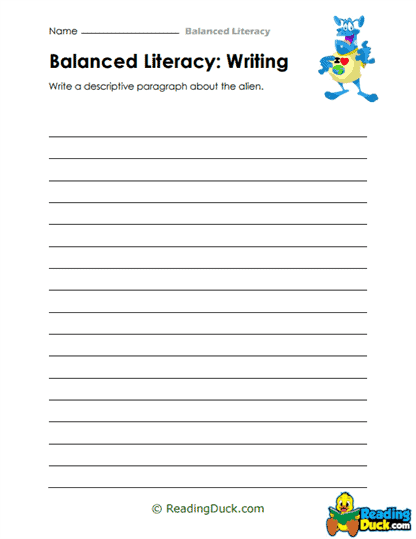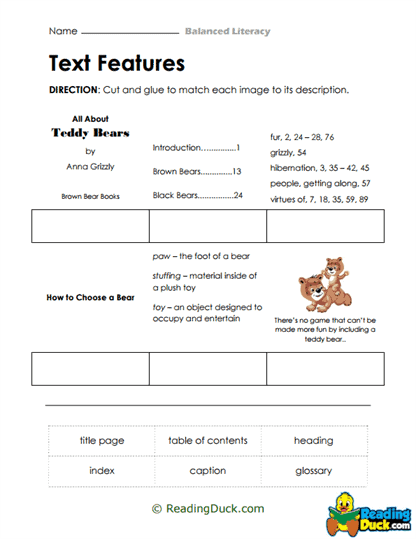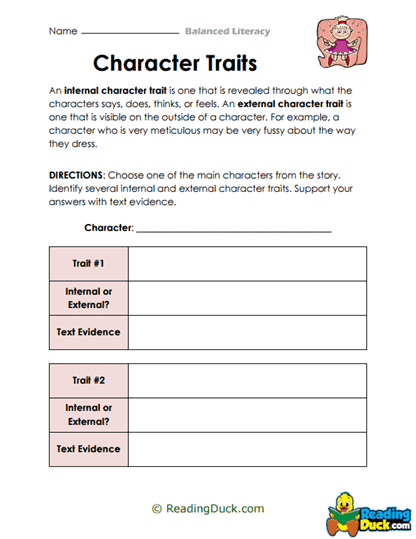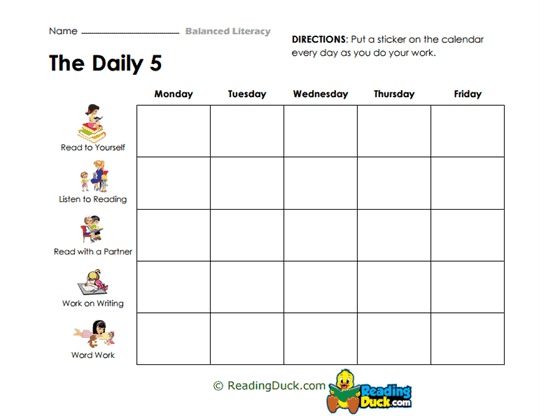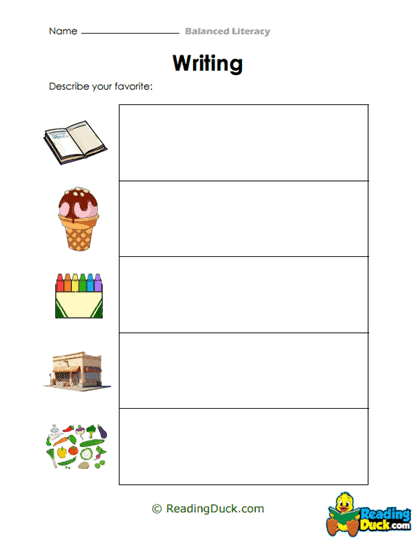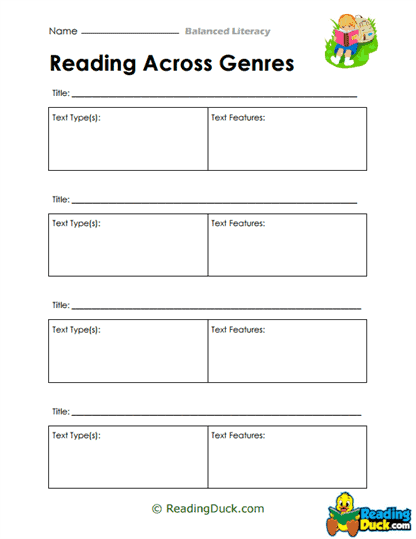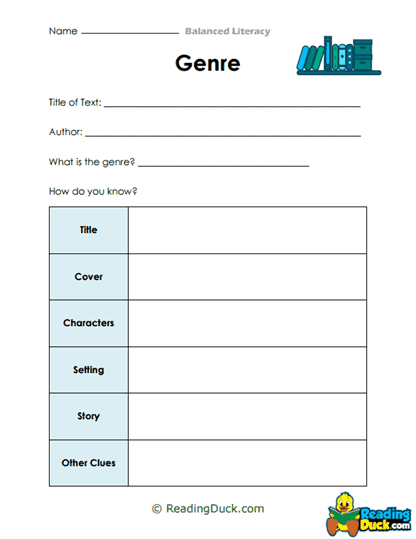Balanced Literacy Worksheets
About Our Balanced Literacy Worksheets
Our Balanced Literacy Worksheets are designed to support students in developing a well-rounded set of literacy skills, with a focus on writing proficiency. Balanced literacy is an instructional approach that integrates reading, writing, speaking, and listening to create a comprehensive learning experience. These worksheets are carefully crafted to guide students through various aspects of writing, helping them develop key skills such as organization, expression, and critical thinking.
Available in convenient PDF format, the worksheets are simple to view, download, and print, making them easy for educators and parents to use. Each worksheet includes a downloadable answer key, ensuring that teachers can efficiently assess student progress and provide timely feedback. Whether used in the classroom or at home, these resources are ideal for creating a balanced literacy environment where students can grow as confident, competent writers.
Understanding Balanced Literacy in Writing
Balanced literacy is an educational approach that aims to give students a well-rounded experience by combining multiple forms of literacy—reading, writing, speaking, and listening. In terms of writing, balanced literacy helps students understand the full scope of communication by encouraging them to write with purpose, organize their thoughts clearly, and engage with texts critically.
Writing is one of the core elements in a balanced literacy framework, and these worksheets focus specifically on developing this crucial skill. The balanced literacy approach emphasizes both explicit instruction in writing and opportunities for independent practice, ensuring students can apply the skills they learn in meaningful ways. Through a mix of guided activities and creative exercises, our worksheets help students explore different forms of writing, whether they’re composing a story, writing a persuasive essay, or responding to a text.
Students who engage in balanced literacy writing activities will develop:
- Clear and Coherent Writing: By focusing on structure, students learn how to logically organize their ideas, whether they are writing narratives, expository pieces, or opinion essays.
- Creative Expression: Balanced literacy encourages creativity in writing, allowing students to explore personal voice and imaginative storytelling.
- Critical Thinking: When responding to texts or crafting arguments, students learn to think critically about their writing choices, building stronger analytical skills that are essential for academic success.
This holistic approach to writing instruction ensures that students are not just mastering the mechanics of writing but are also learning how to use writing as a tool for communication, creativity, and problem-solving.
How Balanced Literacy Worksheets Build Core Writing Skills
Our Balanced Literacy Worksheets are designed to enhance students’ core writing skills in a variety of ways, allowing them to improve their ability to communicate effectively across different types of writing. Whether students are focusing on narrative, informative, or persuasive writing, these worksheets provide structured practice that builds essential competencies.
Some key writing skills students will strengthen include:
- Logical Organization: Writing in a balanced literacy framework emphasizes the importance of clear, structured thinking. Students learn to outline their ideas and present them in a coherent order, improving their ability to create well-organized essays and stories.
- Descriptive Writing: Through balanced literacy exercises, students practice using vivid details, sensory language, and creative descriptions to engage readers, which is crucial for narrative and creative writing.
- Argumentation and Persuasion: For persuasive writing tasks, students learn how to construct logical arguments, provide supporting evidence, and use rhetorical strategies to convince their audience.
- Response Writing: Whether responding to a prompt, text, or question, students develop their ability to articulate their thoughts clearly and effectively, supporting their ideas with relevant details.
These writing skills are fundamental not only for classroom success but also for lifelong communication. By mastering these elements of writing, students can apply what they’ve learned across different subjects and real-world contexts, from academic essays to creative projects.
Integrating Balanced Literacy Worksheets Into Lesson Plans
One of the primary strengths of our Balanced Literacy Worksheets is their flexibility. These worksheets can be easily integrated into broader lesson plans, whether the focus is on writing, reading comprehension, or cross-curricular projects. The balanced literacy approach naturally complements a wide range of academic subjects, making it simple to align the worksheets with existing curricula and lesson goals.
Examples of how to integrate the worksheets include:
- In Writing Lessons: These worksheets can serve as direct writing practice or as extensions of writing lessons where students are learning specific techniques such as thesis development, narrative structure, or descriptive writing.
- In Reading Comprehension Units: Balanced literacy encourages students to respond to texts they’ve read. These worksheets can guide students in writing reflections, summaries, or analytical essays, deepening their engagement with reading material.
- In Literature Units: For literature studies, students can use these worksheets to write character analyses, explore themes, or craft creative responses to the literature they are reading.
Teachers and parents can customize the worksheets based on specific lesson objectives, ensuring that students are working on relevant skills while also gaining exposure to different types of writing. Whether you are working within a formal curriculum or providing supplementary writing instruction, these worksheets offer a practical way to reinforce balanced literacy principles in any educational setting.
Aligning with Educational Standards
Our Balanced Literacy Worksheets are carefully aligned with educational standards, including the Common Core State Standards and other local curriculum guidelines. This ensures that students who use these worksheets are working on skills that are essential for academic success and are meeting the benchmarks established by their educational institutions.
The focus on writing clarity, logical organization, and critical thinking within these worksheets helps students build the foundation they need to excel in standardized assessments and writing tasks across the curriculum. Educators can confidently integrate these worksheets into their teaching plans, knowing that they are supporting students in mastering skills that are key components of modern education standards.
Additionally, these worksheets promote literacy in a way that fosters both student independence and guided learning, aligning with best practices in education today. Students are encouraged not only to complete tasks but to understand the process behind effective writing, preparing them for more advanced writing assignments and real-world communication.
Encouraging Critical Thinking and Analysis
Our Balanced Literacy Worksheets go beyond basic writing exercises, emphasizing critical thinking and deeper analysis of texts and writing tasks. Instead of simply practicing sentence structure or grammar, students are encouraged to explore the relationships between ideas, analyze different writing styles, and think critically about their own writing choices.
For example, students may be asked to:
- Analyze an Argument: In persuasive writing tasks, students will not only construct their own arguments but also evaluate how effectively other writers present and support their claims. This fosters an analytical mindset that is valuable in both reading and writing.
- Make Textual Connections: Through reading responses, students will learn to connect their writing with the themes, ideas, and characters they encounter in literature, strengthening their analytical and interpretative skills.
- Reflect on Writing Strategies: Balanced literacy encourages students to reflect on the strategies they use in their own writing, helping them understand how to communicate more clearly and effectively.
These activities build critical writing habits that extend beyond the worksheet. By encouraging analysis and reflection, our worksheets help students become more thoughtful writers who are capable of engaging with complex ideas and expressing themselves confidently.
Time-Saving and Teacher-Friendly Resources
We know that educators and parents value resources that are easy to use and time-efficient. Our Balanced Literacy Worksheets are designed with clear instructions and straightforward layouts, making them simple to integrate into any lesson plan with minimal preparation required. Teachers can quickly download the worksheets in PDF format, print them for class, and use the accompanying answer keys for easy assessment.
These worksheets save teachers time, allowing for more direct interaction with students and less time spent on grading and planning. Whether used as homework, classwork, or review exercises, they provide a reliable, ready-to-use tool that supports both teaching and learning in a balanced literacy framework.
Conclusion
Our Balanced Literacy Worksheets are a comprehensive resource that helps students master critical writing skills while also building a deeper understanding of reading, thinking, and communication. Available in easy-to-use PDF format, these worksheets are a valuable addition to any classroom or home learning environment, providing structured, standards-aligned practice in writing and critical thinking.
With their flexibility and focus on key writing skills, these worksheets can be seamlessly integrated into broader lesson plans, ensuring that students are developing as confident, competent writers. Designed to promote critical analysis and encourage deeper connections between ideas, they offer much more than simple practice—they foster a well-rounded literacy experience that prepares students for success in both academic and real-world contexts.
